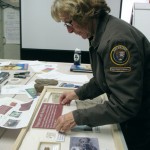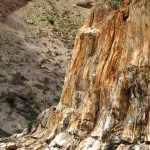 The Friends of the Florissant Fossil Beds, Inc. is a 501(c)(3) nonprofit dedicated to assisting the National Park Service in preserving, protecting, and interpreting the natural and historical resources of Florissant Fossil Beds National Monument. The Friends’ primary mission is to raise funds and provide assistance to projects that preserve the fossils of Florissant, as well as to organize and promote programs and activities that support the Monument’s educational, conservation, and scientific research objectives.
The Friends of the Florissant Fossil Beds, Inc. is a 501(c)(3) nonprofit dedicated to assisting the National Park Service in preserving, protecting, and interpreting the natural and historical resources of Florissant Fossil Beds National Monument. The Friends’ primary mission is to raise funds and provide assistance to projects that preserve the fossils of Florissant, as well as to organize and promote programs and activities that support the Monument’s educational, conservation, and scientific research objectives.
The Friends accomplish their goals through partnerships with a variety of local and regional organizations, including the Pikes Peak Historical Society, Colorado College, the Colorado Alliance for Environmental Education, the Gold Belt Byway, the Rocky Mountain Nature Association, and the Lake George Gem & Mineral Club.
Florissant Fossil Beds National Monument is a National Park Service unit located just outside the town of Florissant, Colorado, on the Gold Belt Byway, a National Scenic Byway. The park was established in 1969 by President Richard M. Nixon after local citizens and concerned scientists petitioned for the site to be protected from development due to its scientific importance. The legal counsel of the Defenders of Florissant wrote the following, marking a landmark case in the history of environmental law:
The Florissant fossils are to geology, paleontology, paleobotany, palynology, and evolution what the Rosetta Stone was to Egyptology. To sacrifice this 34 million year old record for 30-year mortgages and the basements of the A-frame ghettoes of the seventies is like wrapping fish with the Dead Sea Scrolls.
 Florissant is best known for its giant fossil redwood (Sequoia) stumps, but beneath the surface lie beds of shale–the Florissant Formation–deposited in an ancient lake about 34 million years ago (about 31 million years after dinosaurs became extinct). Between the layers of shale are beautifully fossilized fossils of insects, plants, and fish, as well as microscopic algae and pollen. Fossils of some mammals, like the extinct rhinoceros-like brontothere, have also been found at Florissant, and active scientific research continues today.
Florissant is best known for its giant fossil redwood (Sequoia) stumps, but beneath the surface lie beds of shale–the Florissant Formation–deposited in an ancient lake about 34 million years ago (about 31 million years after dinosaurs became extinct). Between the layers of shale are beautifully fossilized fossils of insects, plants, and fish, as well as microscopic algae and pollen. Fossils of some mammals, like the extinct rhinoceros-like brontothere, have also been found at Florissant, and active scientific research continues today.
The Florissant Formation is a fossil site of great scientific significance, showing the diversity of the late Eocene ecosystem and preserving important detail of the organisms–even the structure of the fossil wood is visible under a microscope. The park offers an online museum for anyone interested in learning more about the paleontology of Florissant. Park paleontologist Dr. Herbert W. Meyer has also authored a book, The Fossils of Florissant (Smithsonian, 2003), about the fossils.
Friends Accomplishments
Since their founding in 1987, the Friends have continually supported the education and research part of the mission of the Monument through offering both financial support and activities and events. Here are just a few of our accomplishments:
- Planning and funding the 50th Anniversary Banquet for the Monument in 2019.
- Travel and Research funding for the Monument Paleontologist
- Funding for other special Monument related special celebrations and events
- Planning and funding the Seminars for the last 27 years (offering virtual seminars during COVID)
- Funding at least one paleontology intern or one interpretive intern or both each year
- Funding for a variety of printed materials
- Funding for the water hook up for the A-frame so that it can be sued for housing for interns and researchers on a short term basis – 2021
After over 30 years, the Friends continue to be active supporters of the park today. From here you can see the Friends’ event schedule, read about how to help, or contact the Friends with questions or comments.
